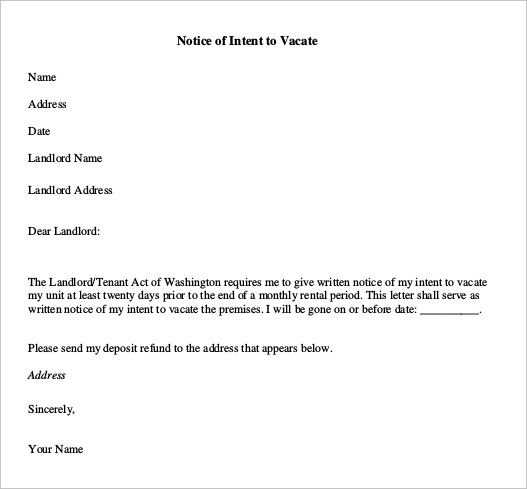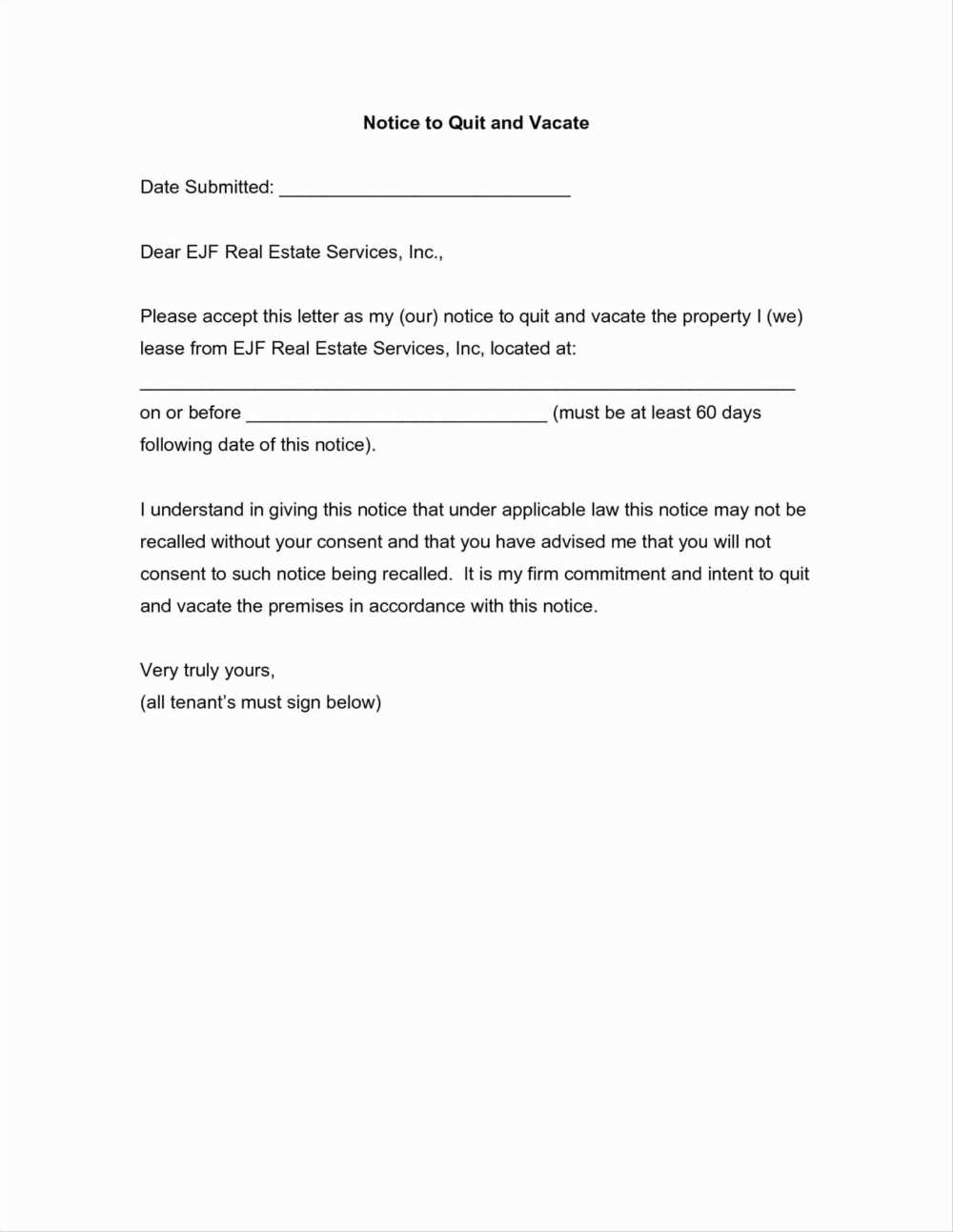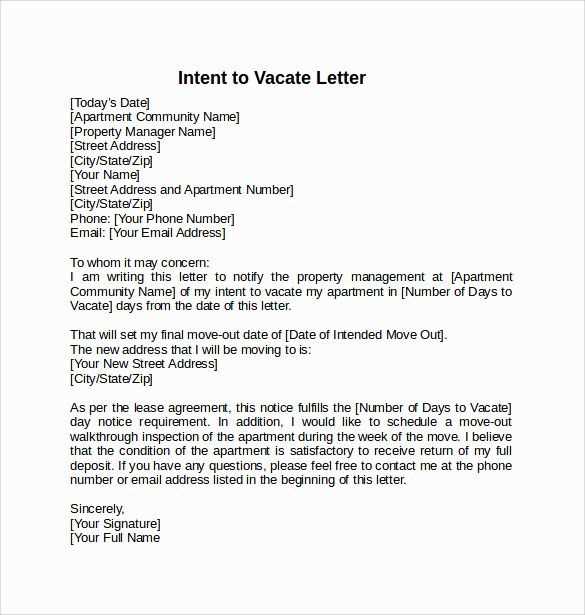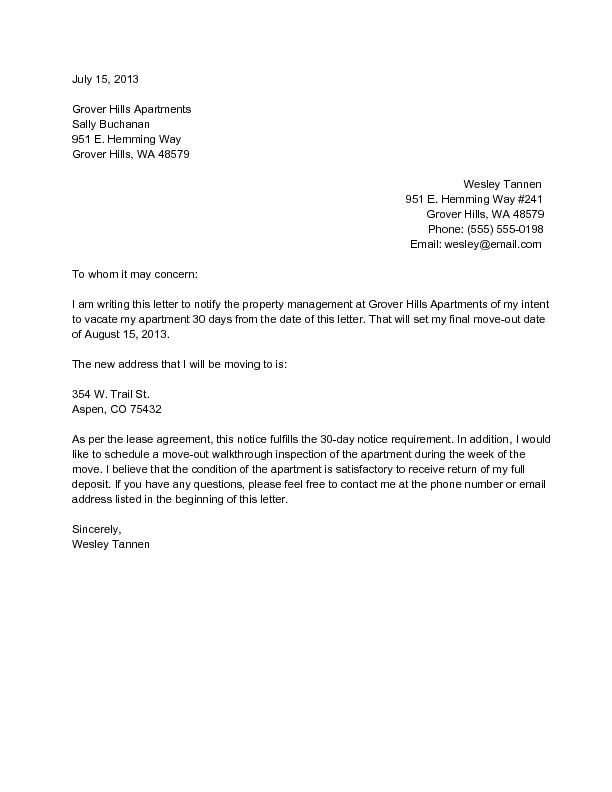Letter of Intent to Vacate Apartment Template

When you’re planning to leave your current living space, it’s essential to formally notify the property owner or management. A well-structured communication helps ensure a smooth transition and maintains a professional relationship.
This document serves as a formal way to inform the landlord of your decision. It should be clear, concise, and respectful, highlighting important details such as your move-out date and any requirements for the property handover.
Properly drafting this communication will also help avoid misunderstandings regarding security deposits, final inspections, or any other obligations. Using an organized approach allows you to stay on track and meet all necessary deadlines without issues.
Understanding the Purpose of a Letter
When you decide to move out of your current residence, it’s essential to communicate your plans to the property owner or manager. This formal notification serves to outline your departure and help both parties prepare for the transition. Properly documenting this decision ensures that no misunderstandings occur regarding responsibilities or deadlines.
Clarifying Expectations
By sending this notification, you’re making sure that both sides are on the same page. It helps the landlord or management team prepare for your exit, schedule any necessary inspections, and handle logistics related to the handover. At the same time, it allows you to confirm your move-out date and ensure that all obligations are met before you leave.
Maintaining Professionalism
Such communication reflects your professionalism and respect for the rental agreement. It provides a record of your actions, which can help avoid disputes over deposits, damages, or other issues that might arise. It’s not just about fulfilling a requirement, but also about ensuring a smooth end to the rental arrangement.
Key Components of the Letter
When crafting a formal notification of your decision to leave a rental space, it’s important to include all the relevant information to avoid confusion. The document should clearly outline your plans and address key aspects of the departure process to ensure everything is covered properly.
Essential Information

The document should start with the date you plan to move out, giving the landlord enough time to prepare. Also, it’s important to include your current address, the rental period, and any necessary references to the lease agreement. This helps establish a clear connection between the communication and the terms of the contract.
Details on Property Condition and Handover
Providing a brief overview of the property’s condition and your plans for its handover is also crucial. This may include scheduling a final inspection or offering to arrange repairs. The goal is to ensure both parties are aware of the expectations before the actual move-out date.
When to Send Your Intent Letter
Timing plays a crucial role when notifying the landlord about your decision to leave. Sending the communication too early might lead to confusion, while waiting too long could result in missed deadlines or complications. Understanding the right time to send this formal notice ensures a smooth process for both parties involved.
Typically, rental agreements outline the required notice period, which is usually anywhere from 30 to 60 days before the planned departure. Make sure to check your lease for specific terms to avoid any issues.
| Notice Period | Time to Send Notification |
|---|---|
| 30 days | Send at least 30 days prior to move-out |
| 60 days | Send at least 60 days prior to move-out |
| Lease terms vary | Check lease for specific timing |
By adhering to these guidelines, you ensure a respectful and legally sound notification, giving enough time for the landlord to prepare for your departure and for you to complete the necessary tasks before moving out.
How to Format Your Document Properly

When preparing your formal communication to inform the landlord of your decision to move out, proper formatting is essential for clarity and professionalism. A well-structured document helps ensure that the important information is easy to find and leaves a positive impression.
Start by including your contact information at the top, followed by the date. Then, address the document to the appropriate person or department, using a polite and formal salutation. Make sure to use clear paragraphs to separate key points such as the move-out date, property condition, and any relevant details about the final inspection.
Keep the tone respectful and concise, avoiding unnecessary details. A clean, organized format reflects your professionalism and helps prevent misunderstandings later on.
Common Mistakes to Avoid

When crafting your formal notice to the landlord regarding your decision to leave, there are several common mistakes that could lead to confusion or complications. It’s important to be aware of these pitfalls to ensure that your communication is clear, professional, and effective.
Providing Inaccurate Information
One of the most significant errors is providing incorrect details, such as the wrong move-out date or outdated contact information. Double-check everything before sending to ensure accuracy. Inaccurate information can cause delays or misunderstandings about your plans.
Not Following Required Notice Period
Another mistake is failing to adhere to the notice period outlined in the lease agreement. Many agreements require a 30- or 60-day notice. Not complying with this can lead to penalties or complications in getting your security deposit refunded. Make sure to review the lease for specific requirements and plan accordingly.
Tips for a Smooth Apartment Transition
Ensuring a seamless move-out process requires planning and attention to detail. By following a few simple tips, you can make the transition much easier and avoid unnecessary complications.
- Plan Ahead: Start preparing early to avoid last-minute stress. Give yourself ample time to organize your belongings, schedule movers, and notify all relevant parties.
- Communicate with the Landlord: Keep your landlord informed about your plans, including your move-out date and any arrangements for inspections or repairs.
- Inspect the Space: Conduct a thorough inspection of the property before your departure. Take note of any damages and make arrangements to fix them to avoid disputes later.
By following these tips, you ensure that the transition is as smooth and hassle-free as possible. Proper preparation will leave both you and the landlord satisfied with the outcome.